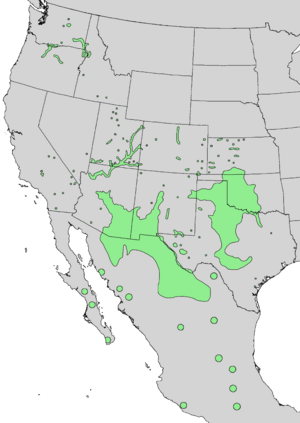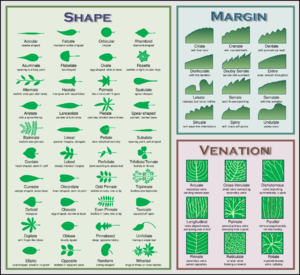Celtis reticulata facts for kids
Quick facts for kids Celtis reticulata |
|
|---|---|
 |
|
| Scientific classification | |
| Genus: |
Celtis
|
| Species: |
reticulata
|
 |
|
| Natural range of Celtis reticulata | |
The Celtis reticulata, also known as the netleaf hackberry, is a cool tree found in western North America. It's a small to medium-sized tree that loses its leaves in the fall, just like many trees do. People also call it the western hackberry or Douglas hackberry.
Contents
Where the Netleaf Hackberry Lives
This tree has been around for a long time! Scientists have found signs of it from thousands of years ago.
Ancient Homes
Long ago, after the last Ice Age, the netleaf hackberry grew in places like northern Arizona. This was when the climate was different. Today, you won't find it in those exact spots.
Current Homes
Today, you can find the netleaf hackberry in many places.
- In the eastern parts, it grows in the hills of Texas, Oklahoma, Kansas, and Louisiana.
- Its central home includes the Rio Grande river area. It also grows in the Chihuahuan Desert across southern Arizona, New Mexico, western Texas, and parts of Mexico.
- You can also spot it in the mountains of northern Arizona, like the White Mountains.
- Along the Colorado River, from the Grand Canyon up through Utah to western Colorado, it finds good places to grow.
- Out west, it lives in the Columbia River Basin in Oregon, Washington, and western Idaho.
- It's also found in Southern California. This includes the foothills of the Sierra Nevada, and some mountain ranges like the Peninsular Ranges. It even grows in certain "sky islands" in the Mojave Desert.
What the Netleaf Hackberry Looks Like
The netleaf hackberry is usually a small tree. It often grows to be about 20 to 30 feet (6 to 10 meters) tall. Its trunk can be 6 to 10 inches (15 to 25 cm) wide. Some trees can even reach up to 70 feet tall! Sometimes, it looks more like a large bush than a tall tree. It likes to grow in places that are 500 to 1700 meters (about 1600 to 5600 feet) high.
Bark and Twigs
The bark of the hackberry is usually gray or brownish-gray. The trunk has cool vertical ridges that look like a checkerboard pattern. Younger branches are covered with very tiny hairs.
Leaves
Its leaves are about half an inch to three inches (2 to 8 cm) long. Most are about two inches (5 to 6 cm) long. They are shaped like a spear or an egg, and are often a bit uneven at the bottom. The leaves feel leathery and have clear, net-like veins. Their edges can be smooth or have small teeth. The top of the leaf is dark green, and the bottom is yellowish-green. The small stems that hold the leaves are usually about 5 to 6 mm long.
Flowers and Fruit
The flowers of the netleaf hackberry are super tiny, only about 1/12 of an inch (2 mm) across. They grow alone or in small groups. The fruit is a small, firm berry. It can be brownish to purple and is about 5 to 12 mm wide. The berry has a thin layer of pulp around a seed.
Similar Trees
It's easy to mix up the netleaf hackberry with other hackberry trees. These include the spiny hackberry (Celtis pallida), the common hackberry (Celtis occidentalis), and the sugarberry (Celtis laevigata).
How People and Animals Use It
The netleaf hackberry is useful to both wildlife and people.
Food Source
Many insects, especially certain moth caterpillars, love to eat the leaves of this tree. The berries are also a tasty snack for different kinds of wildlife.
For a long time, Native American groups in the Southwestern United States have used the berries and seeds as food. The Apache and Navajo people ate them fresh. They also ground them up to store for later.
Growing the Tree
Plant nurseries grow the netleaf hackberry. It's a popular choice for gardens and natural landscapes. This is because it's a native plant that can handle dry conditions, making it great for drought-tolerant gardens. It's also used in projects to bring nature back to certain areas.


